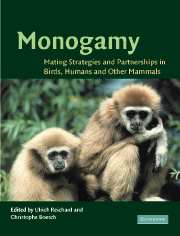Book contents
- Frontmatter
- Contents
- List of contributors
- Acknowledgements
- Introduction
- PART I Evolution of social monogamy
- CHAPTER 2 The evolution of monogamy: mating relationships, parental care and sexual selection
- CHAPTER 3 Mate guarding and the evolution of social monogamy in mammals
- CHAPTER 4 The evolution of social monogamy in primates
- CHAPTER 5 The evolution of social and reproductive monogamy in Peromyscus: evidence from Peromyscus californicus (the California mouse)
- PART II Reproductive strategies of socially monogamous males and females
- PART III Reproductive strategies of human and non-human primates
- Index
CHAPTER 4 - The evolution of social monogamy in primates
Published online by Cambridge University Press: 05 July 2014
- Frontmatter
- Contents
- List of contributors
- Acknowledgements
- Introduction
- PART I Evolution of social monogamy
- CHAPTER 2 The evolution of monogamy: mating relationships, parental care and sexual selection
- CHAPTER 3 Mate guarding and the evolution of social monogamy in mammals
- CHAPTER 4 The evolution of social monogamy in primates
- CHAPTER 5 The evolution of social and reproductive monogamy in Peromyscus: evidence from Peromyscus californicus (the California mouse)
- PART II Reproductive strategies of socially monogamous males and females
- PART III Reproductive strategies of human and non-human primates
- Index
Summary
INTRODUCTION
Empathy probably guides most hypotheses about social Behaviour (Hrdy, 1986), or at least the amount of attention given to particular problems. For several decades now, behavioural biologists have been fascinated with sexual monogamy, or its absence, in both birds and mammals. However, the question of the evolution of social monogamy has also been a topic of sustained interest (e.g., Kleiman, 1977; Barlow, 1988; Komers & Brotherton, 1997; Fuentes, 2000). Unfortunately, despite this interest, a comprehensive model of the evolution of social monogamy, at least among mammals, has so far eluded us, quite possibly because there are both multiple pathways leading up to it, and multiple benefits favouring its maintenance in different lineages. There is, accordingly, little hope for a simple unitary model for the evolution of social monogamy.
In this chapter, we examine the evolution of social monogamy in one mammalian lineage: primates. Primates are a very suitable group for a study of the evolution of social monogamy. Pairs are remarkably common among them (Kleiman, 1977; Müller & Thalmann, 2000), and range from dispersed to associated, and from variable to uniform. In the following paragraphs we outline our approach to this question.
Our focus is on the evolution of pairs as a social system, i.e., the associations and social interactions among individual animals. The social system encompasses the social organization (its size, composition, and spatiotemporal cohesion), the mating system, and social structure (patterning of social interactions and relationships among members of the social unit) (Kappeler & van Schaik, 2002).
- Type
- Chapter
- Information
- MonogamyMating Strategies and Partnerships in Birds, Humans and Other Mammals, pp. 59 - 80Publisher: Cambridge University PressPrint publication year: 2003
- 31
- Cited by



